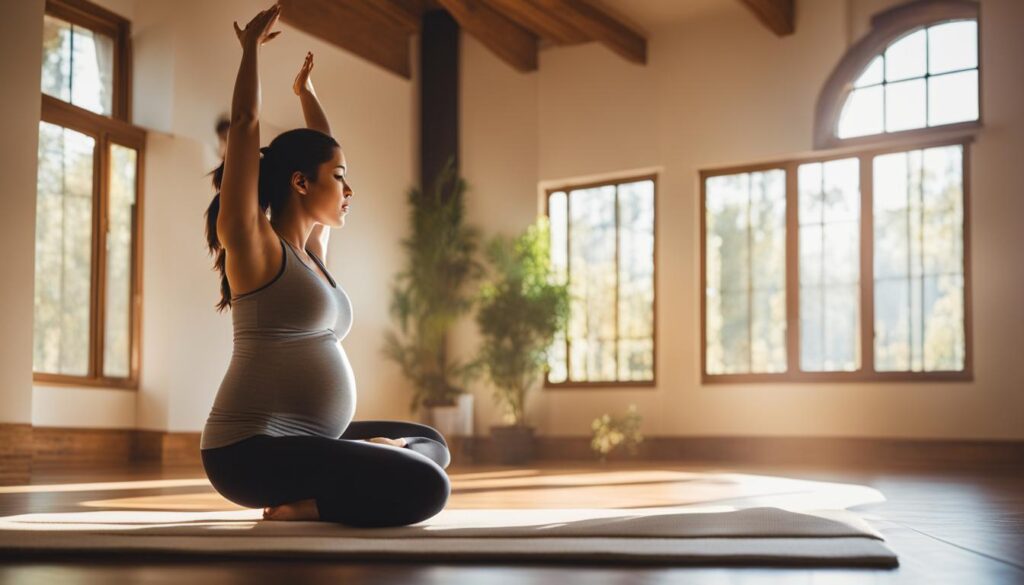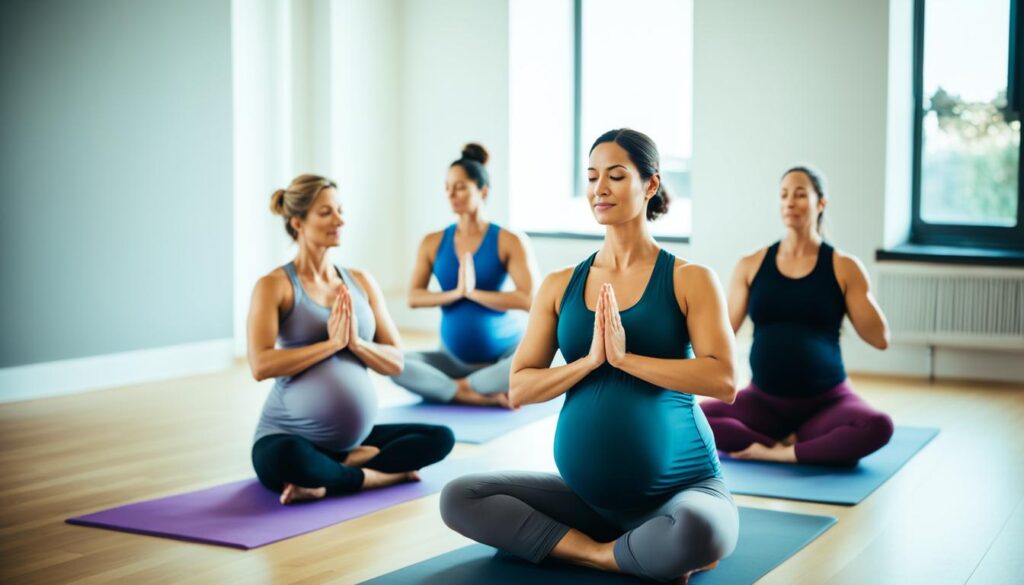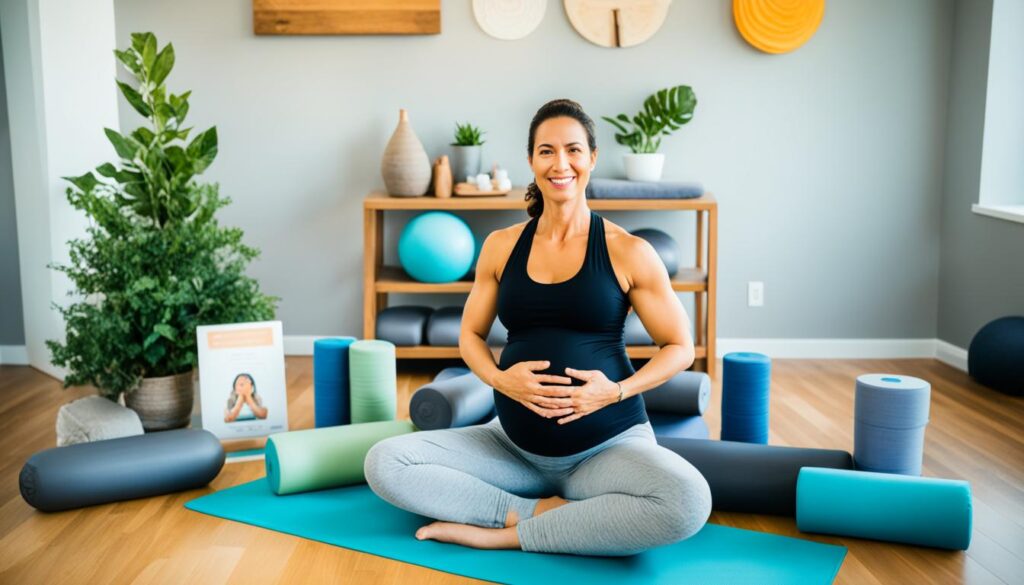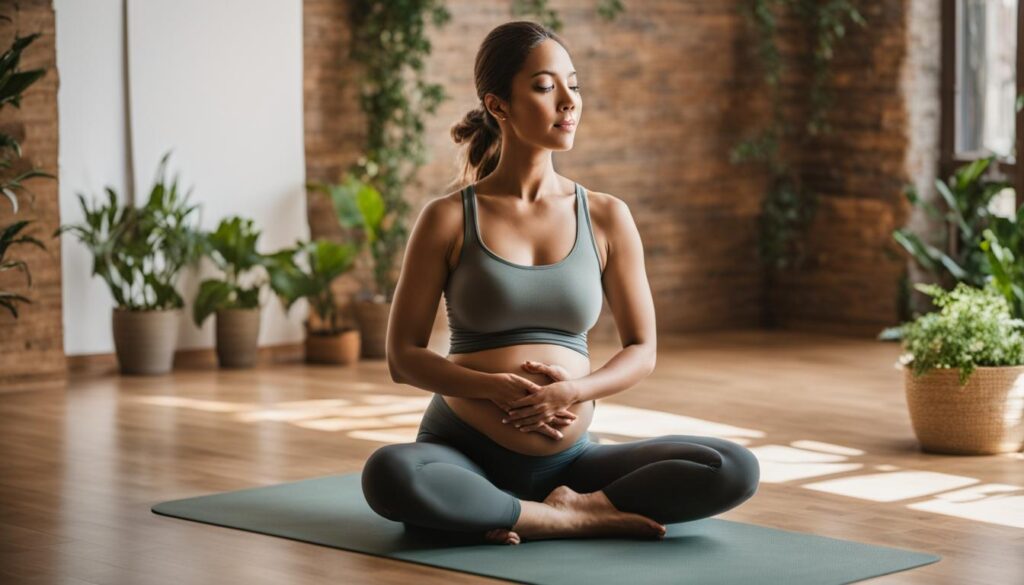If you’re an expecting mother, you might wonder which exercise routines are safe for both you and your baby. Luckily, one form of exercise that is both gentle and effective during pregnancy is prenatal yoga. Not only can it keep you active and physically fit, but it can also provide a range of emotional benefits during this transformative time.
During pregnancy, your body goes through many changes, and it’s essential to practice safe and gentle exercises that meet your unique needs. Prenatal yoga offers a range of poses and techniques that can strengthen your muscles, increase flexibility, and help you relax. If you’ve never tried prenatal yoga before, it’s never too late to start – even if you’re in your third trimester.
Key Takeaways
- Prenatal yoga is safe and gentle for expecting mothers
- It can strengthen muscles, increase flexibility, and help with relaxation
- Prenatal yoga can support overall prenatal health and wellness
- You can start prenatal yoga at any stage of pregnancy
- Consult with your healthcare provider before starting any exercise program during pregnancy
The Benefits of Prenatal Yoga
Are you looking for a safe and effective way to stay fit during pregnancy? Practicing prenatal yoga may be the answer!
Not only is prenatal yoga a gentle form of exercise that can be adapted to every stage of pregnancy, but it also offers a range of benefits for both your physical and emotional well-being. Here are just a few of the many benefits of prenatal yoga:
| Benefit | Description |
|---|---|
| Promotes Physical Strength | Practicing prenatal yoga can help strengthen your muscles, particularly your core and pelvic floor, which can provide additional support during labor and delivery. |
| Improves Flexibility | Prenatal yoga can help improve flexibility and range of motion, which can be especially beneficial during pregnancy when your body is constantly changing. |
| Relieves Pregnancy Discomforts | Many prenatal yoga poses can help relieve common pregnancy discomforts, such as back pain and swelling. |
| Reduces Stress and Anxiety | Practicing yoga during pregnancy can help reduce stress and anxiety, promoting a greater sense of calm and well-being. |
| Fosters Overall Well-being | Prenatal yoga can provide a sense of community and support, fostering overall well-being and promoting a positive mindset during pregnancy. |
As you can see, the benefits of prenatal yoga extend far beyond physical fitness. By prioritizing your prenatal health and wellness with holistic prenatal care, you can experience a more comfortable, peaceful, and empowered pregnancy.

Safe and Gentle Prenatal Yoga Poses
When practicing yoga during pregnancy, it is crucial to choose poses that are safe and appropriate for each trimester while providing gentle prenatal workouts. The following yoga poses are excellent options for expecting mothers, promoting physical strength and flexibility, reducing stress, and fostering overall wellness.
1. Cat-Cow Stretch
The Cat-Cow Stretch is an excellent yoga pose for stretching the spine and relieving back pain. Begin on your hands and knees, with your hands under your shoulders and your knees under your hips. As you inhale, arch your back, lifting your head and tailbone towards the sky (Cow pose). As you exhale, round your spine, tucking your chin to your chest and drawing your tailbone down (Cat pose). Repeat ten times, moving slowly and smoothly.
2. Pigeon Pose
The Pigeon Pose is an effective hip opener and can help relieve tension in the hips and lower back. Begin on all fours, then slide your right knee up towards your right hand. Extend your left leg behind you, keeping your hips square. Place a cushion or blanket beneath your right hip if necessary. Hold for thirty seconds, then repeat on the other side.

3. Warrior II Pose
The Warrior II Pose helps strengthen the legs and stretch the hips and chest. Begin in a standing position, then step your left foot back about four feet. Turn your left foot out to a 90-degree angle, then bend your right knee. Spread your arms out at shoulder level, with your gaze over your right hand. Hold for thirty seconds, then repeat on the other side.
4. Bound Angle Pose
The Bound Angle Pose (also known as the Butterfly Pose) is an excellent hip opener, promoting flexibility and reducing discomfort during pregnancy. Sit on the floor with the soles of your feet touching, then gently bring your heels towards you as close as possible. Hold your feet with your hands, extending your spine, then gently press your knees towards the floor. Hold for thirty seconds, then release.
Remember to listen to your body and avoid any poses that cause discomfort or strain. It’s always a good idea to consult with a healthcare provider before starting any new exercise program during pregnancy, including prenatal yoga poses, and to use gentle prenatal workouts.
Incorporating Prenatal Yoga into Your Fitness Routine
Yoga is a great form of exercise during pregnancy, offering gentle movements that help maintain flexibility and ease pregnancy discomforts. To incorporate prenatal yoga into your fitness routine, consider the following tips:
Frequency and Duration of Practice
It’s essential to listen to your body during pregnancy and adjust your yoga practice accordingly. As a general rule, it’s best to practice prenatal yoga at least three times a week. Aim for sessions that last between 30 and 60 minutes, depending on what feels comfortable for you. Remember, prenatal yoga is meant to be gentle and calming, so there’s no need to push yourself too hard or feel obligated to complete a full hour every time.
Prenatal Yoga Classes
Attending a prenatal yoga class is an excellent way to practice yoga in a safe and supportive environment. Look for classes that are specifically designed for pregnant women and led by experienced prenatal yoga instructors. Check your local yoga studios, community centers, or hospitals for available classes. If you’re unable to attend a physical class, consider joining online prenatal yoga classes that allow you to practice from the comfort of your own home.

Tip: Make sure to let your instructor know that you’re pregnant before starting any class. They will be able to provide modifications and guidance to ensure a safe and comfortable practice for you and your baby.
Online Resources
If attending classes isn’t feasible, there are plenty of online resources available that provide guidance on prenatal yoga practice. Seek out reputable websites or apps that offer prenatal yoga videos or guided sessions. When starting any new prenatal exercise program, it’s important to do your research and only follow reliable sources.
By incorporating prenatal yoga into your fitness routine, you can enjoy the many benefits of this gentle and calming form of exercise. Remember to take it slow, listen to your body, and enjoy the journey of pregnancy.
Modifications and Props for Prenatal Yoga
As your body changes during pregnancy, you may find some yoga poses more challenging to execute. Fortunately, there are modifications and props that can help you practice yoga safely and comfortably. By making simple adjustments to traditional poses, you can continue to benefit from your yoga practice throughout your pregnancy.
Some modifications include widening your stance, using a chair or wall for support, and adjusting the angle of your body. Props such as blocks, straps, blankets, and bolsters can provide additional support and comfort during yoga poses. For example, placing a block under your hand during a triangle pose can help you balance while improving your alignment. Similarly, using a bolster under your hips in a seated forward fold can help relieve pressure on your lower back while allowing you to relax into the pose.
It’s important to remember that your comfort and safety should always come first when practicing prenatal yoga. Listen to your body and adjust your practice as needed. Here’s a list of some modifications and props that can enhance your yoga practice during pregnancy:
| Modified Pose | Prop |
|---|---|
| Wide-Legged Forward Fold | Blocks or chair for support |
| Pigeon Pose | Bolster or blanket to support your hip |
| Warrior II Pose | Widening your stance to adapt to your changing center of gravity |
| Supported Child’s Pose | Bolster or blanket under your hips to relieve pressure in your lower back |
| Tree Pose | Wall or chair for support |
Remember to consult with your healthcare provider before starting any prenatal exercise program. With the right modifications and props, prenatal yoga can be a safe and gentle way to stay fit and ease discomfort during pregnancy.

Precautions and Safety Guidelines for Prenatal Yoga
When practicing prenatal yoga, your safety and well-being, as well as your baby’s health, are of the utmost importance. Here are some important precautions and safety guidelines to keep in mind:
- Warm-up: Always begin with a gentle warm-up to prepare your body for the practice. This might include stretching, breathing exercises, or simple movements.
- Avoid certain poses and movements: As your body changes during pregnancy, certain poses might become uncomfortable or unsafe. Avoid poses that involve lying flat on your back, twisting or compressing your abdomen, or putting too much pressure on your joints.
- Stay hydrated: Drink plenty of water before, during, and after your practice to avoid dehydration.
- Listen to your body: Pay attention to how you feel during your practice and modify or skip poses as needed. Avoid pushing yourself too hard or overexerting.
- Consult with a healthcare provider: Before starting any exercise program during pregnancy, consult with your healthcare provider to ensure that it is safe for you and your baby.
By following these precautions and safety guidelines, you can enjoy the benefits of prenatal yoga while ensuring a safe and healthy practice.

“The practice of prenatal yoga should be empowering and nourishing for your body, mind, and soul during pregnancy.”
Prenatal Yoga for Emotional Well-being
During pregnancy, it’s essential to take care of your emotional health as well as your physical well-being. Prenatal yoga is a practice that can help you do just that. The gentle and mindful movements of yoga can help you connect with your body and your growing baby while also managing the mood swings and stress that often come with pregnancy.
Through prenatal yoga, you can cultivate a sense of inner peace and serenity that will serve you well throughout your pregnancy journey and beyond. By breathing deeply and focusing on the present moment, you can release tension and anxiety, promoting a calming and soothing environment for both you and your baby.
Not only can prenatal yoga help you manage negative emotions and reduce stress, but it can also help you build positive feelings of self-confidence, empowerment, and joy. As you move through the poses, you can feel a sense of accomplishment and connection with your body, which can be especially important for women experiencing body image issues during pregnancy.
By prioritizing emotional well-being through prenatal yoga, you can set yourself up for a positive and healthy pregnancy experience. Take the time to listen to your body, connect with your baby, and practice self-care as you prepare for this exciting new chapter in your life.
“Yoga is a light, which once lit, will never dim. The better your practice, the brighter the flame.” —B.K.S. Iyengar

Prenatal Yoga and Bonding with Your Baby
Prenatal yoga is not only great for your physical and emotional well-being during pregnancy but also a special way to bond with your baby. Through yoga practice, you cultivate a deeper mind-body connection that can have a positive impact on your baby’s development.
As you move through gentle prenatal yoga poses, feel free to talk to your baby, visualize a positive birth experience, or simply enjoy the present moment. When practicing yoga mindfully, you’re more likely to be in tune with your body and your baby’s needs, creating a sense of intimacy and closeness that can be hard to replicate otherwise. Moreover, the endorphins released during exercise can have a positive impact on both you and your baby’s mood.
While research in this area is still evolving, studies suggest that practicing prenatal yoga may improve fetal outcomes, such as reduced instances of low birth weight and preterm labor. Additionally, prenatal yoga may foster a sense of confidence and readiness for labor and delivery, which can help ease anxiety and stress during this transitional time.
Whether you’re practicing prenatal yoga in a class, online, or at home, take advantage of this special opportunity to connect with your baby and foster a sense of well-being as you prepare for motherhood.

Conclusion
As an expecting mother, incorporating prenatal yoga into your fitness routine can have numerous benefits for both you and your baby. Not only does it provide safe and gentle exercises for expecting mothers, but it also promotes overall prenatal health and wellness. Through prenatal yoga, you can improve physical strength, flexibility, and alleviate pregnancy discomforts. Additionally, it reduces stress and anxiety, fosters emotional well-being, and enhances the bond between you and your baby. Prenatal yoga poses are designed to be safe and gentle, and with the right modifications and props, you can practice comfortably throughout your pregnancy.
Remember, before starting any exercise program during pregnancy, it’s crucial to consult with your healthcare provider and follow important precautions and safety guidelines. But with the right guidance and resources, prenatal yoga can provide holistic prenatal care and empower you on your journey to motherhood. So if you’re looking for a safe, gentle, and effective exercise option during pregnancy, consider giving prenatal yoga a try. Your body, mind, and baby will thank you for it.
FAQ
What is prenatal yoga?
Prenatal yoga is a form of exercise specifically designed for expecting mothers. It combines gentle stretching, strengthening exercises, and breathing techniques to promote physical and emotional well-being during pregnancy.
Is prenatal yoga safe for pregnant women?
Yes, prenatal yoga is generally considered safe for pregnant women. However, it is important to consult with your healthcare provider before starting any exercise program during pregnancy to ensure it is appropriate for your individual needs and medical history.
What are the benefits of practicing prenatal yoga?
Prenatal yoga offers numerous benefits, including improved physical strength and flexibility, relief from common pregnancy discomforts, reduced stress and anxiety, enhanced emotional well-being, and a deeper connection with your baby.
Are there specific poses I should avoid during prenatal yoga?
Yes, there are some poses that are generally avoided during prenatal yoga as they may put strain on the abdomen or increase the risk of injury. It is best to work with a qualified prenatal yoga instructor who can guide you through safe and appropriate poses for your stage of pregnancy.
How often should I practice prenatal yoga?
The frequency of your prenatal yoga practice will depend on your comfort level and medical advice. In general, it is recommended to aim for 2-3 sessions per week. However, listen to your body and make adjustments as needed.
Do I need any special equipment or props for prenatal yoga?
While not necessary, some props like blocks, straps, and bolsters can enhance comfort and support during prenatal yoga. Your instructor or online resources can guide you on how to use these props effectively.
Are there prenatal yoga classes available for expecting mothers?
Yes, many fitness studios and community centers offer prenatal yoga classes. These classes are specifically designed for pregnant women and are led by instructors with expertise in prenatal yoga. Additionally, there are online resources and videos available for practicing prenatal yoga at home.
What precautions should I take when practicing prenatal yoga?
When practicing prenatal yoga, it is important to stay hydrated, listen to your body, and make modifications as needed. Avoid overexertion, overheating, and any poses or movements that feel uncomfortable or cause pain. Always consult with your healthcare provider before starting any exercise program during pregnancy.
Can prenatal yoga help with emotional well-being during pregnancy?
Yes, prenatal yoga can contribute to emotional well-being during pregnancy. The practice promotes relaxation, reduces stress and anxiety, and helps expecting mothers connect with their bodies and their growing babies. It can be a valuable tool for managing mood swings and promoting a sense of inner peace.
How does prenatal yoga enhance the bond between an expecting mother and her baby?
Prenatal yoga fosters a mind-body connection, allowing expecting mothers to be present in the moment and focus on the sensations within their bodies. This heightened sense of awareness and connection often leads to a stronger bond with the growing baby, creating a nurturing and supportive environment both physically and emotionally.


Leave a Comment